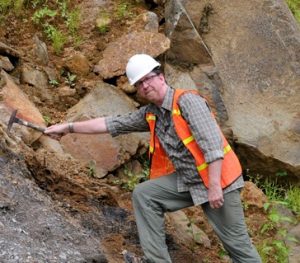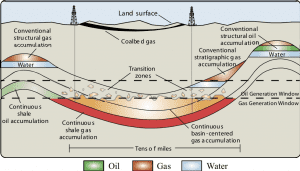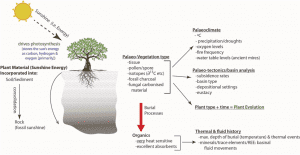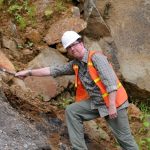[Tim A. Moore, Ph.D – Professional Expert in Unconventional Energy]

It is widely recognised that we live in the hydrocarbon age. Coal ignited the industrial revolution in the 1800s and with the discovery of liquid petroleum, oil allowed mass transport to be affordable and provided electricity to millions of homes. Lately, natural gas has gained prominence in response to climate change.
Exploration of liquid and gaseous hydrocarbons, in particular, has moved from easier, ‘conventional’, targets such as porous and permeable sandstone reservoirs in anticlines (Fig. 1) to ‘unconventional’ units that are distinctly less permeable and require innovative approaches to access hydrocarbons economically.
The unconventional units yield primarily gas from coal, shale and tight sandstone lithologies. In a world attempting to decarbonise, natural gas is seen as a transition energy source as renewables are developed and become more affordable.

Figure 1. Schematic of conventional and unconventional hydrocarbon deposits (Charpentier & Ahlbrant, 2003).
It is hard to overstate how important unconventional gas will be over the next few decades. Unlocking these deposits, however, is a different story. Indonesia is in a unique position, with extensive unconventional coal seam gas and shale gas deposits. But to develop these resources will require research by industry, academics and governmental institutions. Without these collaborations, the gas will remain in the ground and more carbon intensive and polluting sources will be used to power the ever-increasing standard of living of a growing population. Ultimately, leadership must come from governments.
Even if the world transitioned to 100% renewables today, study of hydrocarbons should not cease. These hydrocarbons, especially those organics from non-marine, terrestrial plant sources, are incredibly useful proxies to the Earth’s past.
Fundamentally, organics from plants use the sun’s energy to drive photosynthesis, which in turn creates large molecular structures made up of C, H, O, and N. When these organics get buried they preserve clues to the past. Unlocking these clues, and thus an understanding of events in deep time (Fig. 2), is critical for our human endeavours. Lets remember, the truth is out there, and it’s probably in the organics!

Figure 2: Some of the things organic material can tell us about Earth’s past.

Tim A. Moore
aSchool of Earth and Atmospheric Sciences, Queensland University of Technology, Brisbane, Australia
bSchool of Resources and Geoscience, China University of Mining and Technology, Xuzhou, China
cCipher Consulting Pty Ltd, 6 Stardust Street, Kenmore, Queensland, 4069, Australi

Ikuti Kami!